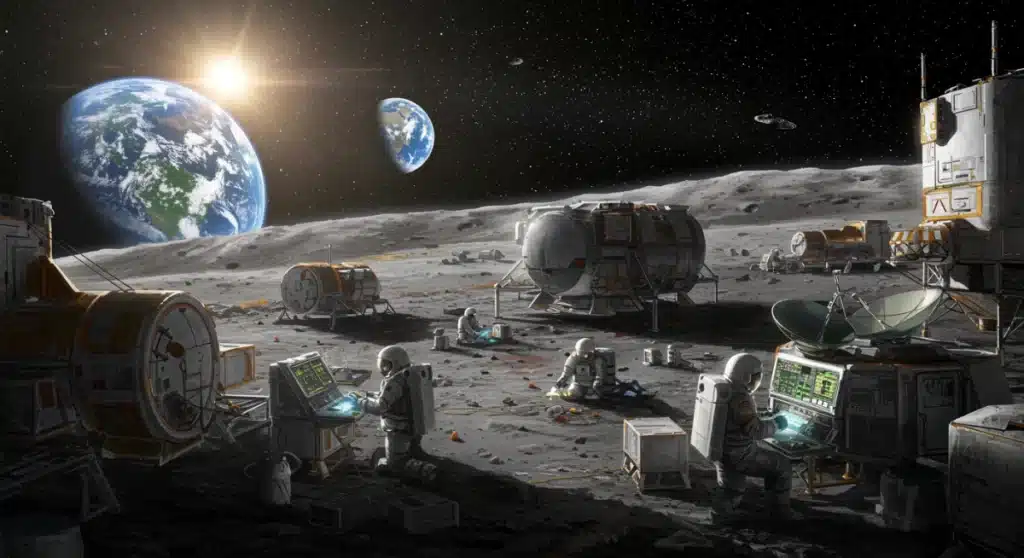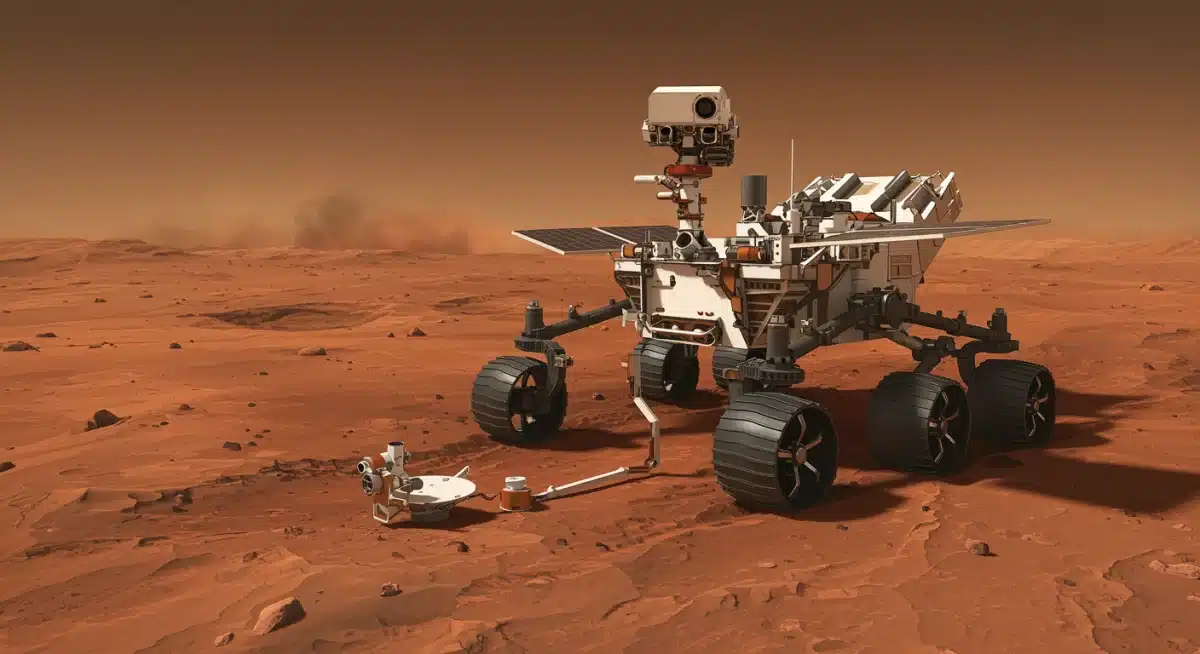Space Exploration in 2025: Key Missions and Tech Updates

Recent updates confirm 2025 as a pivotal year for space exploration, featuring critical missions to the Moon and Mars, alongside groundbreaking technological advancements in propulsion and in-situ resource utilization.
As 2025 approaches, the landscape of Space Exploration in 2025: Key Missions and Technologies Driving the Next Frontier (RECENT UPDATES) is rapidly evolving, promising a year of significant breakthroughs and ambitious endeavors. Humanity’s push beyond Earth’s confines continues to accelerate, driven by both national space agencies and private enterprises.
Artemis III: A Return to the Lunar Surface
The highly anticipated Artemis III mission remains a cornerstone of 2025’s space calendar, marking NASA’s planned return of humans to the lunar surface. This mission is critical for establishing a long-term human presence on the Moon and serves as a vital step toward future missions to Mars.
Recent reports from NASA confirm that preparations are intensifying, with crew selections and training accelerating. The mission aims to land astronauts near the Moon’s South Pole, an area believed to harbor significant water ice, crucial for sustainable lunar operations.
Lunar South Pole Significance
The selection of the lunar South Pole is strategic, primarily due to the potential presence of water ice in permanently shadowed regions. This ice could be processed into drinking water, breathable oxygen, and rocket fuel, drastically reducing the cost and complexity of future missions.
- Water Ice Extraction: Key to sustainable lunar presence.
- Resource Utilization: Essential for in-situ propellant production.
- Scientific Research: Unlocking lunar geological and environmental secrets.
The development of the Space Launch System (SLS) rocket and the Orion spacecraft continues, with recent test data providing confidence in their readiness. However, challenges related to the Human Landing System (HLS) and spacesuit development persist, as reported by NASA officials as of late 2024.
Mars Sample Return Campaign: Advancing Martian Science
The Mars Sample Return (MSR) campaign, a joint effort by NASA and ESA, is set to make significant strides in 2025. This ambitious multi-mission program aims to bring scientifically selected Martian rock and soil samples back to Earth for detailed analysis. These samples, currently being collected by NASA’s Perseverance rover, hold the potential to answer fundamental questions about the existence of past life on Mars and the planet’s geological history.
The next phases of the MSR campaign involve the deployment of the Sample Retrieval Lander and the Mars Ascent Vehicle (MAV). These components are crucial for collecting Perseverance’s cached samples and launching them into Mars orbit, a feat never before attempted.
Technological Hurdles and Solutions
Bringing samples from another planet presents unprecedented engineering challenges. The MAV, for instance, must be robust enough to operate in the harsh Martian environment and powerful enough to escape Mars’s gravity. ESA’s Earth Return Orbiter is also under development, designed to capture the samples in Mars orbit and transport them safely back to Earth.
- Mars Ascent Vehicle (MAV): Critical for orbital insertion of samples.
- Earth Return Orbiter (ERO): Designed for interplanetary sample transport.
- Contamination Control: Strict protocols to prevent terrestrial contamination of Martian samples.
As of recent updates, the development of these highly specialized systems is on track, though minor schedule adjustments are always possible with missions of this complexity. The scientific community eagerly awaits the arrival of these samples, which could revolutionize our understanding of planetary evolution and astrobiology.
Private Sector Innovations: Starship and Beyond
The private space sector, led by companies like SpaceX, is poised for major advancements in 2025, particularly with the continued development and testing of Starship. SpaceX’s fully reusable launch system is designed to transport both cargo and crew to Earth orbit, the Moon, and Mars, promising to dramatically reduce the cost of space access.
Ongoing flight tests of Starship and its Super Heavy booster are providing invaluable data, as reported by SpaceX. Each test, regardless of its ultimate outcome, contributes to refining the design and operational procedures for this groundbreaking vehicle. The goal for 2025 includes achieving orbital reliability and potentially conducting initial uncrewed lunar missions in preparation for Artemis III.
Reusable Rocketry and Space Tourism
The concept of full reusability is central to Starship’s economic model, aiming to make space travel as routine and affordable as air travel. This innovation has significant implications not only for scientific missions but also for the burgeoning space tourism industry.
- Cost Reduction: Reusability dramatically lowers launch expenses.
- Increased Access: More frequent and affordable access to space.
- Space Tourism: Opening new possibilities for private citizens in space.
Other private entities are also making strides. Blue Origin continues its work on the New Glenn heavy-lift rocket, and various startups are developing innovative propulsion systems and small satellite deployment technologies. This competitive environment fosters rapid innovation and accelerates the pace of space exploration.
Advanced Propulsion Systems: Enabling Deeper Space Travel
The quest for faster and more efficient travel within our solar system and beyond continues to drive innovation in advanced propulsion systems. In 2025, several key technologies are expected to move closer to operational readiness, drastically impacting future missions.
Electric propulsion, such as Hall effect thrusters and ion engines, is becoming more powerful and reliable, offering high efficiency for long-duration missions. These systems use significantly less propellant than traditional chemical rockets, making them ideal for cargo transport and deep-space probes where mass is a critical constraint.
Nuclear Propulsion and Breakthrough Concepts
Beyond electric propulsion, nuclear thermal propulsion (NTP) and nuclear electric propulsion (NEP) are receiving renewed attention. NTP systems, which heat propellant using a nuclear reactor, could cut travel times to Mars by half, reducing astronaut exposure to radiation and mission costs. NASA and DARPA are actively pursuing demonstration missions for NTP.
- Nuclear Thermal Propulsion (NTP): Faster transit times to Mars.
- Nuclear Electric Propulsion (NEP): High-power, long-duration missions.
- Plasma Propulsion: Advanced concepts for even greater efficiency.
Breakthrough concepts, including solar sails and even theoretical warp drives, continue to be subjects of research, pushing the boundaries of what’s possible. While commercial viability for these more exotic systems is further off, foundational research in 2025 will be vital for their long-term development.
In-Situ Resource Utilization (ISRU): Living Off the Land
In-Situ Resource Utilization (ISRU) is a critical technology for sustainable space exploration, allowing missions to use resources found on celestial bodies rather than bringing everything from Earth. This capability is paramount for establishing permanent bases on the Moon and Mars, significantly reducing mission costs and increasing self-sufficiency.
In 2025, significant progress is anticipated in demonstrating ISRU technologies, particularly concerning water ice extraction and oxygen production. Experiments on the lunar surface and in Martian analog environments are providing crucial data for refining these processes.

Lunar and Martian ISRU Applications
On the Moon, a primary focus is extracting water ice from shadowed craters at the poles. This water can then be electrolyzed to produce hydrogen and oxygen, which can serve as breathable air for astronauts, drinking water, and rocket propellant. Several missions planned for 2025 and beyond will carry ISRU demonstration payloads.
For Mars, the focus includes extracting water from the regolith and producing oxygen from the carbon dioxide-rich atmosphere, as demonstrated by NASA’s MOXIE experiment on the Perseverance rover. These technologies are foundational for future human habitats and return missions from the Red Planet.
- Water Extraction: From lunar ice and Martian regolith.
- Oxygen Production: From water and CO2 (MOXIE-like systems).
- Construction Materials: Utilizing regolith for 3D printing structures.
The development of self-sufficient systems for resource extraction and processing is a key driver for the long-term vision of humanity as a multi-planetary species. The innovations in ISRU in 2025 will lay the groundwork for future off-world economies.
International Collaborations and New Players
Space exploration in 2025 continues to be characterized by strong international collaborations and the emergence of new nations and commercial entities on the global stage. Partnerships between established space agencies like NASA, ESA, JAXA, and CSA are deepening, particularly for complex endeavors such as the Artemis program and the Mars Sample Return. These collaborations pool resources, expertise, and reduce overall risks.
Simultaneously, countries like India (ISRO) and China (CNSA) are rapidly advancing their independent space programs, with ambitious plans for lunar and Martian missions. China, for instance, has outlined plans for its own lunar research station, signaling a growing multi-polar landscape in space exploration.
The Rise of Commercial Space and Global Competition
The commercial space sector is not only innovating but also expanding globally. Companies from various nations are developing launch services, satellite constellations, and in-orbit servicing capabilities. This commercialization is fostering a dynamic environment, increasing access to space and driving down costs.
- International Partnerships: Resource sharing and risk reduction.
- Emerging Space Powers: India, China, and others expanding capabilities.
- Commercial Global Presence: Increasing private sector involvement worldwide.
While competition exists, especially in areas like lunar resource claims, there’s also a growing recognition of the need for international cooperation to address challenges such as space debris management and the establishment of norms for peaceful behavior in space. The year 2025 will see continued dialogue and development in these critical areas, shaping the future of off-world governance.
| Key Mission/Technology | Brief Description |
|---|---|
| Artemis III | NASA’s human return to the lunar surface, focusing on the South Pole for water ice resources. |
| Mars Sample Return | Joint NASA/ESA effort to bring Martian rock and soil samples back to Earth for scientific study. |
| Starship Development | SpaceX’s fully reusable launch system aiming for orbital reliability and lunar missions. |
| ISRU Technologies | Advancements in utilizing extraterrestrial resources for sustainable lunar and Martian operations. |
Frequently Asked Questions About Space Exploration in 2025
The primary goal of the Artemis III mission is to return humans to the lunar surface, specifically targeting the Moon’s South Pole. This mission aims to establish a groundwork for long-term human presence and facilitate research into potential water ice deposits critical for future sustainable operations.
The Mars Sample Return campaign involves a Sample Retrieval Lander and a Mars Ascent Vehicle (MAV) to launch samples into Mars orbit. An Earth Return Orbiter (ERO) will then capture these samples and transport them safely back to Earth for detailed scientific analysis in specialized laboratories.
SpaceX’s Starship is crucial for 2025, aiming for orbital reliability and potential initial uncrewed lunar missions. Its fully reusable design promises to significantly reduce launch costs and increase access to space for both cargo and crew, supporting future Moon and Mars endeavors.
ISRU technologies enable missions to use resources found on celestial bodies, such as water ice or atmospheric gases, to produce necessities like oxygen, water, and propellant. They are vital for reducing reliance on Earth-supplied provisions, making long-duration human missions and permanent bases sustainable and cost-effective.
Significant international collaborations in 2025 include partnerships between NASA, ESA, JAXA, and CSA for missions like Artemis and Mars Sample Return. These collaborations leverage shared expertise and resources, promoting global progress in space exploration while addressing complex technical and logistical challenges.
Looking Ahead
The recent updates surrounding Space Exploration in 2025: Key Missions and Technologies Driving the Next Frontier underscore a dynamic and ambitious period for humanity’s presence in space. The progress on Artemis III, the Mars Sample Return, and private sector innovations like Starship are not isolated events but interconnected threads in a larger narrative of expanding human capabilities beyond Earth. What happens next will involve critical test flights, continued international negotiations on space governance, and the maturation of technologies like ISRU. The decisions and successes of 2025 will profoundly shape the trajectory of space exploration for decades to come, moving us closer to a sustained human presence on other celestial bodies.





